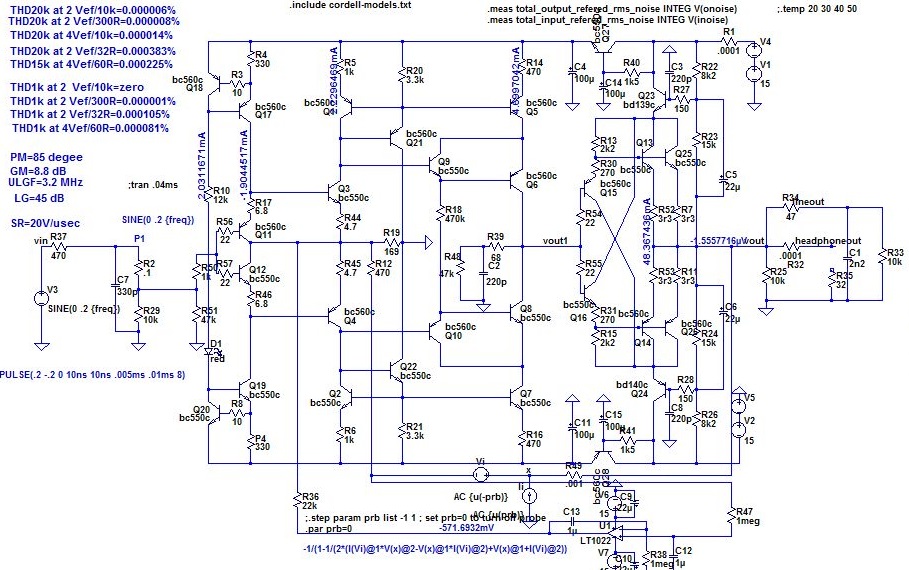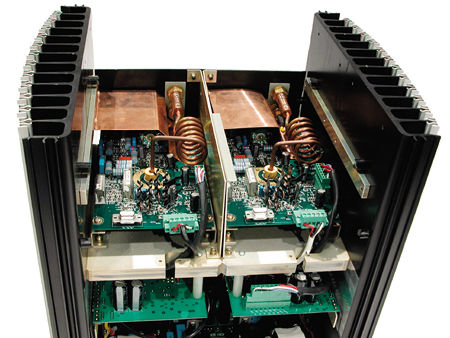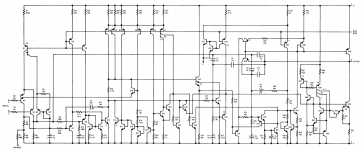Hi, the intention of this thread is just for fun.
What is the most complex (not necessary expensive) amplifier that you ever see?
With complex I mean number of components, stages, configurations, etc.
Only name the amplifier, add schematic or brochure and maybe a link to the amplifier's Page or review. The amplifier can be commercial (for example Yamaha MX-10000) or diy.
The spirit of the thread is not for long discussion, only share the amplifier or amplifiers that you considered more complex.
Regards
What is the most complex (not necessary expensive) amplifier that you ever see?
With complex I mean number of components, stages, configurations, etc.
Only name the amplifier, add schematic or brochure and maybe a link to the amplifier's Page or review. The amplifier can be commercial (for example Yamaha MX-10000) or diy.
The spirit of the thread is not for long discussion, only share the amplifier or amplifiers that you considered more complex.
Regards
Is there a point?
In 1978 Yamaha came out with a new line that had extremely complex circuitry. None of those models sounded as good as the simpler models they replaced.
So again, what is the point?
In 1978 Yamaha came out with a new line that had extremely complex circuitry. None of those models sounded as good as the simpler models they replaced.
So again, what is the point?
If complexity is measured in sheer numbers of transistors then I reckon Doug Self's multiple paralleled NE5532s has a chance of being the leader. I seem to recall 32 chips and for each channel I counted 22 transistors on the DS so this will give a total of 1408. From pictures I see that its 32 chips per channel, so make that 2816 transistors.
However that's potentially beaten by the Blue Circle NSL amp with a grand total of 288 opamps (doesn't say if they're dual or single though) - SoundStage! Ultra | SoundStageUltra.com (UltraAudio.com) | Blue Circle Audio NSL Stereo Amplifier
However that's potentially beaten by the Blue Circle NSL amp with a grand total of 288 opamps (doesn't say if they're dual or single though) - SoundStage! Ultra | SoundStageUltra.com (UltraAudio.com) | Blue Circle Audio NSL Stereo Amplifier
Last edited:
Any Dolby atmos receiver will be horribly complex. For 2 channel the cello audio suite will take some beating.
Is there a point?
So again, what is the point?
This happen when you only read the tittle of the thread and you come to write something. Let me quote my self to you the first words of the thread:
Hi, the intention of this thread is just for fun.
So please, read the entire thread before write a comment.
Regards
I think the Intel 8008 had less BJTs than that amp 😀Probably this amplifier. Click on the white "X" at lower left, to see it at full 100% magnification.
_
You guys need some tube fun in SS forum.
1000W? Champ 1000 Watt Tube Amp
30 tubes? EAR V20 integrated amplifier | Stereophile.com
OTL? 19 tubes/monoblock Transcendent Sound BEAST OTL Tube Amp
1000W? Champ 1000 Watt Tube Amp
30 tubes? EAR V20 integrated amplifier | Stereophile.com
OTL? 19 tubes/monoblock Transcendent Sound BEAST OTL Tube Amp
What is it?
I think I recognize the drawing style (kind wanna say "schematic font") from old National Semiconductor or maybe TI datasheets, but no idea which amplifier that is. In fact now that I think of it, datasheet schematics from many mfrs. have something close to that "font".
Also, I think there's more to it. Another page?
Where does the net Bias Buss go?
Other than that is has standard op amp pinout ...so it doesn't seem like a multiple amp package. So why separate out the bias circuit?
Now I am very curious to know what it is.
More BJTs than an 8008. It might have fewer BJTs than a modern CMOS microprocessor though.
Probably this amplifier. Click on the white "X" at lower left, to see it at full 100% magnification.
_
I think I recognize the drawing style (kind wanna say "schematic font") from old National Semiconductor or maybe TI datasheets, but no idea which amplifier that is. In fact now that I think of it, datasheet schematics from many mfrs. have something close to that "font".
Also, I think there's more to it. Another page?
Where does the net Bias Buss go?
Other than that is has standard op amp pinout ...so it doesn't seem like a multiple amp package. So why separate out the bias circuit?
Now I am very curious to know what it is.
More BJTs than an 8008. It might have fewer BJTs than a modern CMOS microprocessor though.
GainWire mk3 CFA pre/phone amp with very low distortion
It is so complex that I can't get myself to finish building it.

It is so complex that I can't get myself to finish building it.
I don't consider the paralleled or repeated features in some power amplifiers to be complexity. Also in the case of repeated stages that perform selectable modality, I would also not say that they have the same weighting when it comes to complexity.
For parallel and duplicated features say about 1/10th to 1/3rd weighting, and for modality beyond two options, about half weighting, depending on implementation.
For parallel and duplicated features say about 1/10th to 1/3rd weighting, and for modality beyond two options, about half weighting, depending on implementation.
Maybe not the most complex amplifier but yes the most expensive !
Halcro DM-38, Mono amplifier U$D 25K each!


Halcro DM-38, Mono amplifier U$D 25K each!
An externally hosted image should be here but it was not working when we last tested it.


An externally hosted image should be here but it was not working when we last tested it.
Maybe not the most complex amplifier but yes the most expensive !
Halcro DM-38, Mono amplifier U$D 25K each!
Had a chance to spend a few hours listening to a pair of DM-88s on different over a few different trips to a dealer years back. They had by far the best sound signature I've heard of any amplifier: none at all. Clean, clean amps. Ugly, but I'd love a pair.
As for the most expensive...not quite. Those Halcros are downright budget level in the hi-end game these days. I believe that standing for most expensive is held by the Pivetta Opera Only at $2.2 million USD. That amp may even be a challenger for most complex in terms of parts count, but only if it's ever actually assembled. So far only a half-built mock-up has been displayed at shows with no torroids and other heavy parts installed. Not that I can blame him for that; the full spec'd 800kg would be a tad difficult to truck around.
- Status
- Not open for further replies.
- Home
- Amplifiers
- Solid State
- The most complex amplifier that you ever see
